Catocala amica
Catocala amica
kah-TOCK-uh-lahmm
a-MEE-kuh
(Hübner, 1818)
Ephesia amica
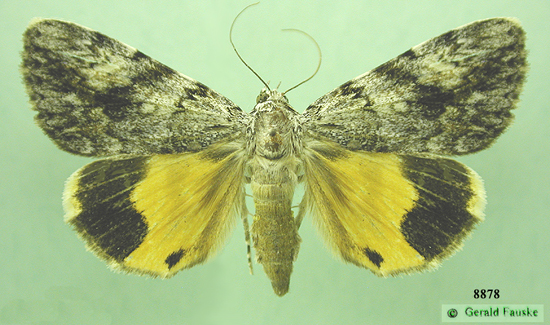
Catocala amica
courtesy of
Gerald Fauske (composited by Bill Oehlke).
Richland County,
North Dakota, Sheyenne National grasslands, August 16, 1996
This site has been created by
Bill Oehlke.
Comments, suggestions and/or additional information are welcomed by Bill.
| TAXONOMY:
Superfamily: Noctuoidea
Family: Erebidae, Leach, [1815]
Subfamily: Erebinae, Leach, [1815]
Tribe: Catocalini, Boisduval, [1828]
Genus: Catocala, Schrank, 1802
|
DISTRIBUTION:
Catocala amica, the Girlfriend
underwing, Hodges# 8878, (wingspan: 35-40mm) flies from southern
Canada: Ontario and Quebec through the eastern United States,
Maine, New Hampshire,
Connecticut, etc.,
westward to Oklahoma and Texas
and northward to Minnesota.
It has also been reported in
Alabama,
Arkansas,
Delaware,
District of Columbia ,
Florida,
Georgia,
Illinois,
Indiana,
Iowa,
Kansas,
Kentucky,
Louisiana,
Maryland,
Massachusetts,
Michigan,
Mississippi,
Missouri,
Nebraska,
New Jersey,
New York,
North Carolina,
North Dakota,
Ohio,
Pennsylvania,
Rhode Island,
South Carolina,
South Dakota,
Tennessee,
Vermont,
Virginia,
West Virginia,
Wisconsin and
Wyoming.
The black postmedian band is absent from the
dorsal (upper) surface of the hindwing, but it is present on the
ventral surface.
Moths come in to lights and to bait.
Catocala amica lineella has now (2010) been elevated to full species status as
Catocala lineella.
Catocala jair is a similar species with wider, blunter
forewings and a much less dentate post medial line.
Catocala amica to the right, courtesy of John Himmelman, Connecticut. |
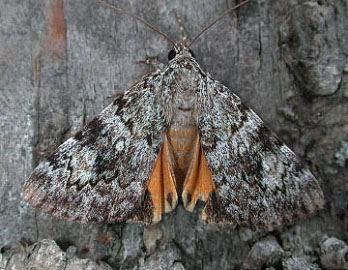
|
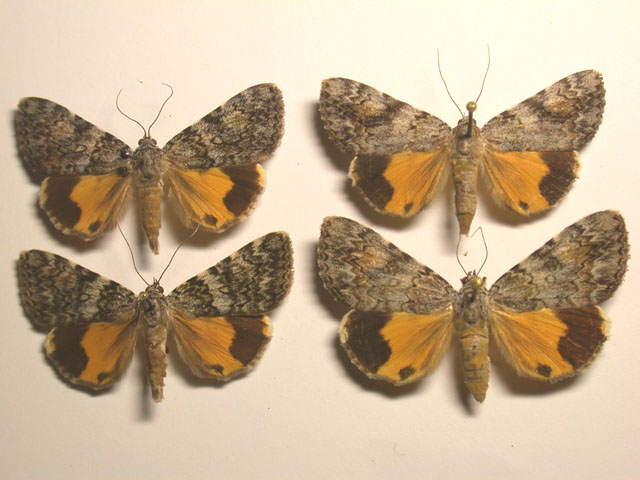
Catocala lineella males (left); Catocala amica pair (right)
Quebec, courtesy of Pierre Legault.
C. lineella generally has a much darker appearance than C. amica.
Visit Catocala amica, Pickens County, northern Georgia,
July 14, 2009, courtesy of Aubrey Scott.
Catocala amica has a pale grey forewing basal area without significant markings. The am line is dark near the
costa, but becomes quite weak as it approaches the inner margin.
The median area is grey with a slightly darker arc running from the costa through and obscuring somewhat the reniform spot,
and then running just below the two dark upper teeth and toward the outer margin.
The subreniform spot is small and closed. There is a brownish grey patch in the area between the reniform spot and the tips of the upper teeth.
The inner half of the subterminal area is brownish grey while the outer half is greyish white. A thin, diffuse dark line separates those halves.
The most distinguishing feature is the absence of a dark median band on the hindwing. The black outer band is truncated well before the anal angle
and is followed by a black dot.
Catocala amica, Windsor, Ontario, courtesy of Maurice Bottos.
| 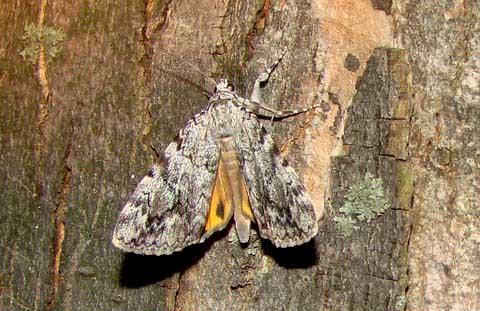 |
FLIGHT TIMES AND PREFERRED FOOD PLANTS:
Catocala amica are usually on the wing
from June until September.
The Catocala amica caterpillar shows a preference for oak
species and probably limits itself to members of the Quercus
genus.
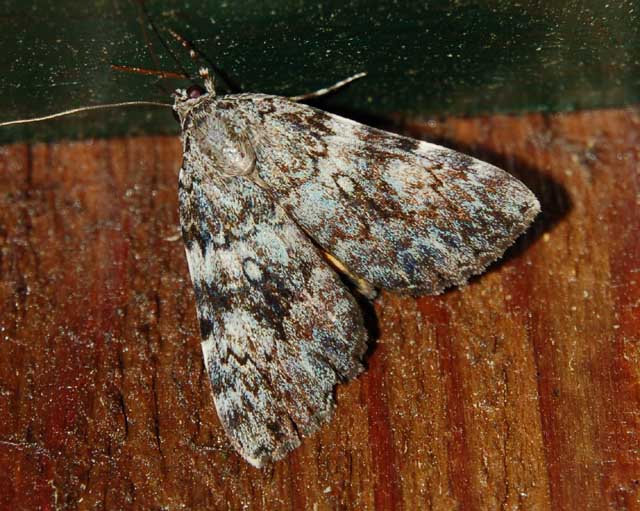
Catocala amica, Chichester, Merrimack County, New Hampshire,
August 18, courtesy of Deb Lievens.
ECLOSION:
Adults eclose from pupae at soil surface.
SCENTING AND MATING:
Catocala amica females
emit an airbourne pheromone and males use their antennae to track the
scent plume.
EGGS, CATERPILLARS, COCOONS AND PUPAE:
Eggs are deposited on
tree bark in the fall and hatch the following spring.
The caterpillar is gray with faint striping. The fifth abdominal
segment is slightly humped and is usually followed by a darkened
saddle.
The eighth abdominal segment features pronounced orange warts.
The top of the head often has a white and orange spot to each side.
The base of the dorsal hairs is black on the dorsal thorax and
black and orange over the abdomen. The fringe hairs are sparse but
relatively long.
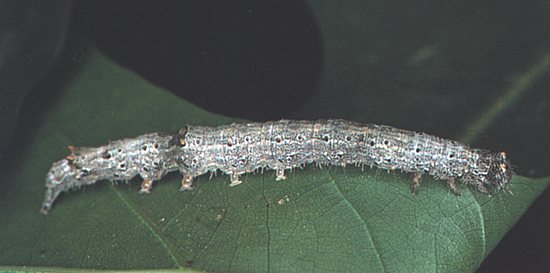
Image courtesy of David L. Wagner and Valerie Giles.
Larval Food Plants
Listed below are primary food plant(s) and alternate food plants.
It is hoped that this alphabetical listing followed by the common
name of the foodplant will prove useful. The list is not exhaustive,
although some species seem very host specific.
Experimenting with closely related foodplants is worthwhile.
Quercus alba
Quercus bicolor
Quercus coccinea
Quercus ilicifolia
Quercus macrocarpa.......
Quercus prinoides
Quercus prinus
Quercus rubra
Quercus stellata
Quercus velutina
|
White oak
Swamp white oak
Scarlet oak
Bear oak
Bur oak
Dwarf chinkapin oak
Chestnut oak
Red oak
Post oak
Black oak
|
Return to Main Index
This page is brought to you by Bill Oehlke and the
WLSS. Pages are on space rented from Bizland. If you would like
to become a "Patron of the Sphingidae/Catocala Sites",
contact Bill.
Please send sightings/images to Bill. I will do my best to respond to
requests for identification help.
Enjoy one of nature's wonderments: Live
Saturniidae (Giant Silkmoth) cocoons.

|

To show appreciation for this site, click on the flashing
butterfly to the left, a link
to many worldwide insect sites. |







